I love soup!
It’s a cozy, comforting meal that is easy to make and customize to your own taste.
I’m always looking for new ways to mix up my recipe, and one of the best ways to do that is by adding different herbs and spices.
These 20 must-try herbs and spices for vegetable soup will make your bowl of soup even tastier and more interesting.
Read Also: The 10 Best Toppings for Vegetable Soup
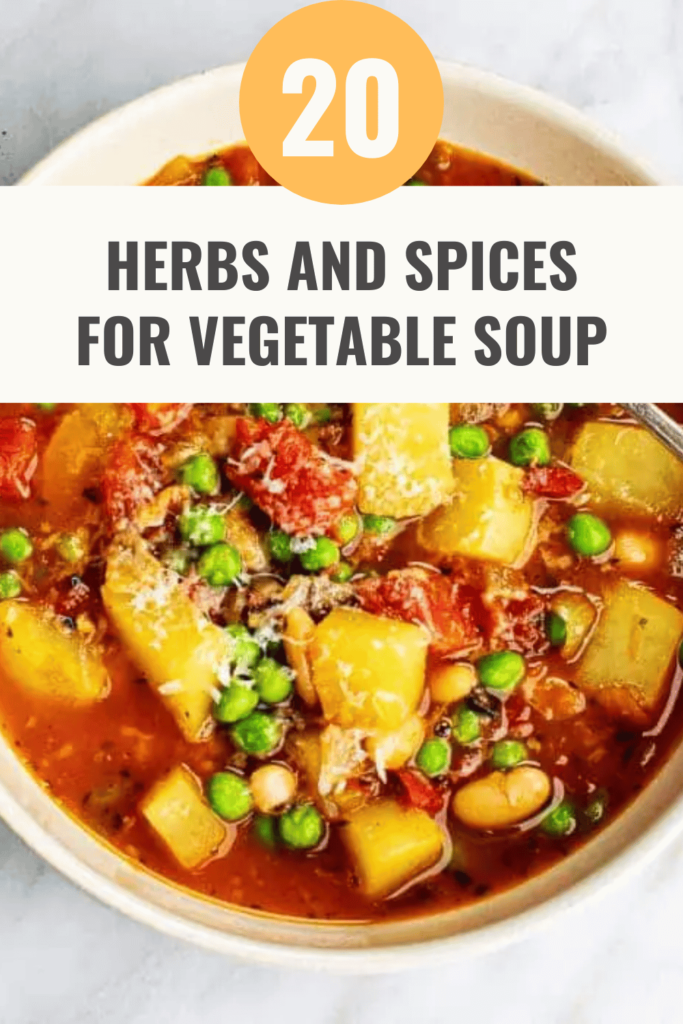
From rosemary and thyme to oregano and marjoram, there’s something for everyone.
Create your own unique flavor combination and enjoy a delicious, nutritious meal.
20 Best Herbs and Spices for Vegetable Soup
Sure, you can always make a great soup with just a few ingredients, but why not add a few herbs and spices to create a unique flavor?
Here are 20 must-try herbs and spices to mix into your next vegetable soup:
1. Parsley

Parsley is a subtle flavor that pairs beautifully with all types of vegetable soups.
It adds brightness and herbal notes that complement the earthiness of garden veggies.
The type you choose should also be taken into account when adding it to your soup.
There are two main varieties: flat-leafed Italian and curly (also known as continental).
Each has its own individual taste, so experiment to figure out which works best for you.
When it comes to using parsley in soups, aim for the ratio of 1 tablespoon per serving size — or roughly 4 tablespoons per quart — if freshly chopped; for dried herbs use ⅛ teaspoon per serving size instead.
If a recipe calls for finely chopped leaves or stems, use one cup first and adjust according to taste.
2. Thyme

Thyme has been used in cooking for many years, so it only makes sense that it would make its way into soups.
It adds an earthy flavor and scent to the soup which can really bring out the flavors of all of your favorite veggies.
So how much should you use?
Generally speaking, about 1 teaspoon for every 8 cups of liquid is a good amount.
However, don’t forget that some stalks may contain more (or less) essential oils than others so always taste first before adding any more if needed!
3. Dried Oregano
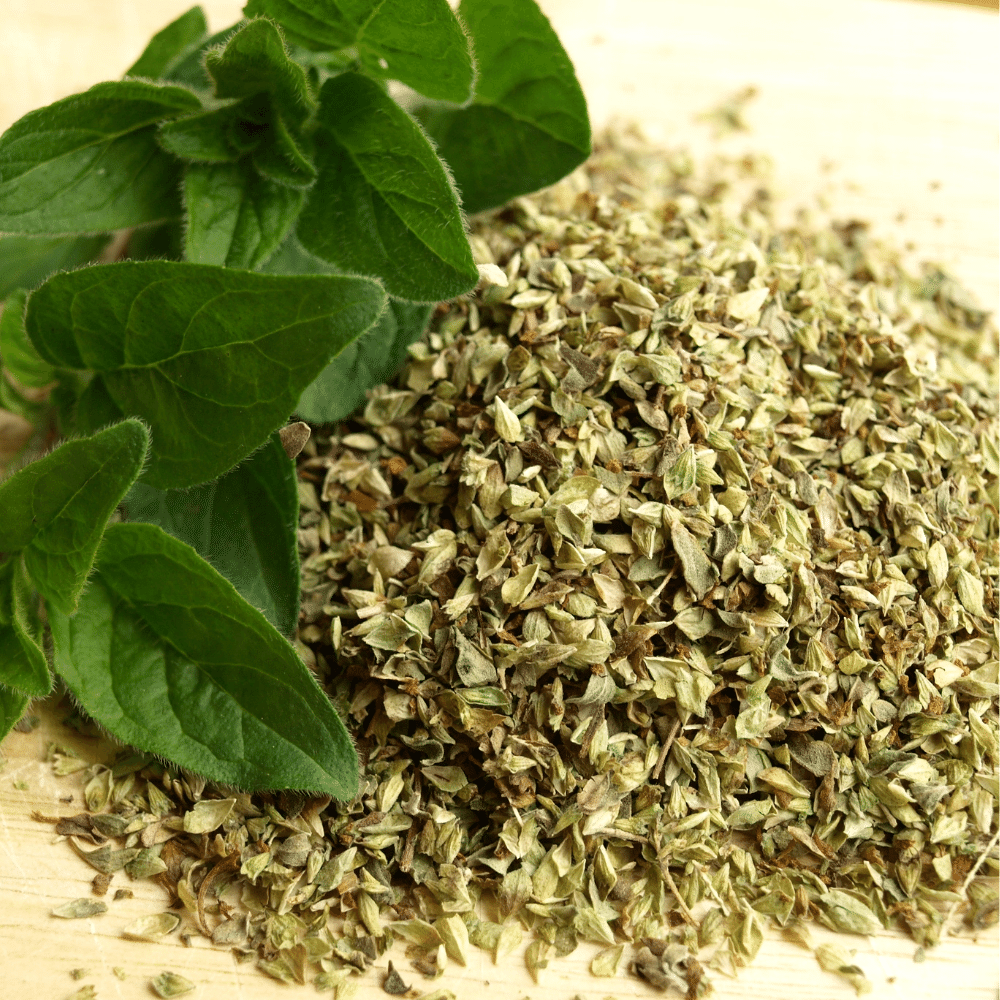
Dried oregano adds an amazing Mediterranean flavor to your veggie soup that brings out the sweetness of all the vegetables.
You can use either fresh or dried oregano for the best flavor.
It will give your unique vegetable medley tremendous depth and earthy complexity with its slightly bittersweet notes that blend nicely with all of the herbs and spices.
So how much do you add?
A good rule of thumb is one teaspoon per quart (1 L) of liquid if you’re using dried oregano flakes—this should be enough to create a subtly amusing yet pleasing taste without overpowering other flavors.
If you enjoy stronger-tasting dishes, go ahead and bump up the amount accordingly.
4. Rosemary

Rosemary is a great herb to use in soups, as it adds a robust flavor that pairs well with vegetables.
As a rule of thumb, start with one half teaspoon per gallon of soup or broth.
You can always add more if needed – but be sparing at first!
Rosemary has an assertive flavor and too much may overwhelm other ingredients in the soup.
When cooking your vegetable soup, add the fresh rosemary at the end of the cooking time so that its delicate flavors don’t become overpowered by heat and steam.
This will ensure you enjoy all its aromatic qualities for maximum enjoyment!
5. Salt

Salt can help bring out the sweetness from carrots, tomatoes, onions, and other vegetables in your soup.
It helps balance their earthy flavors and creates a more complex flavor profile.
In terms of how much salt you should use, it’s best to start with a little at first – about 1 teaspoon for every 8 cups of broth or water being used.
This will give you just enough salted flavor without overpowering your ingredients or making it too salty.
From there, you can adjust according to taste and use additional seasonings like garlic, oregano, or cumin if desired.
6. Black Pepper

Black pepper is one of the most flavorful spices out there and it’s a natural fit for hearty soups like vegetable soup.
The earthiness and pungency of black pepper can elevate any dish.
The key to understanding why black pepper works so well in soup lies in its flavor compounds, which are aromatic oils that give off both hot and sweet notes when heated.
These compounds help bring out the flavors of other ingredients, enhancing the overall taste profile.
When it comes to quantity, a good rule of thumb is to use ¼ teaspoon per cup of liquid or pre-diced vegetables in your veggie soup.
You don’t have to measure if you’d rather not—simply sprinkle it into your pot according to taste preference!
A little bit here and there will go a long way, as too much could make the soup overpoweringly spicy or bitter.
7. Red chili flakes

Chili flakes in soup add vibrant color as well as a nice kick of heat.
These tiny bits of dried chili peppers give the soup an extra element of flavor but don’t overpower the rest of its ingredients.
The amount you use depends on how much spice you can handle—the best part about using chili flakes is that it’s adjustable.
Just start with a small pinch and gradually increase it until you get your desired level of heat.
They bring warmth and depth to hearty soups like this one, making them even more satisfying on chilly nights!
8. Italian seasoning

Italian seasoning is made up of various herbs that bring an earthy, savory flavor to your dish.
Things like oregano, basil, thyme, sage, rosemary, marjoram, and red pepper flakes are all commonly found in Italian seasoning blends.
Italian seasoning has the perfect balance of herbs so it’s not the same as adding one herb at a time – this blend adds depth and flavourful notes that make it stand out from other types of seasonings.
Plus it’s easy because you don’t have to search for individual spices!
As for how much you should use in your vegetable soup – two teaspoons is usually sufficient for every four cups of liquid added to the pot.
9. Marjoram

Marjoram is an herb related to oregano.
It has a warm, herbal flavor with subtle pine and citrus notes.
Marjoram adds a depth of flavor that can easily be overlooked in classic dishes like soups and stews.
Plus, it pairs perfectly with carrots, celery, potatoes, onions, and other aromatics found in most vegetable soups.
For best results add the marjoram at the end of cooking – this will help preserve its freshness and maximize its fragrant aroma.
As far as how much marjoram to use goes it depends on how intense you want the flavor to be – typically between 1/8 teaspoon (a pinch) to 1/2 teaspoon per serving is recommended.
10. Basil

While some people may think that basil is just a garnish, the herb has much more to offer than mere decoration.
Basil is an essential ingredient for many flavorful soups, especially vegetable soups!
Basil adds an aromatic and slightly sweet flavor to any soup.
Now for the million-dollar question: how much should you use?
The answer – it depends on what type of basis you are using in addition to other herbs that have been incorporated into the dish.
For most dishes and soups, I recommend about 1 tablespoon per serving or 1 teaspoon dried basil per cup of liquid used in the recipe.
11. Garlic Powder
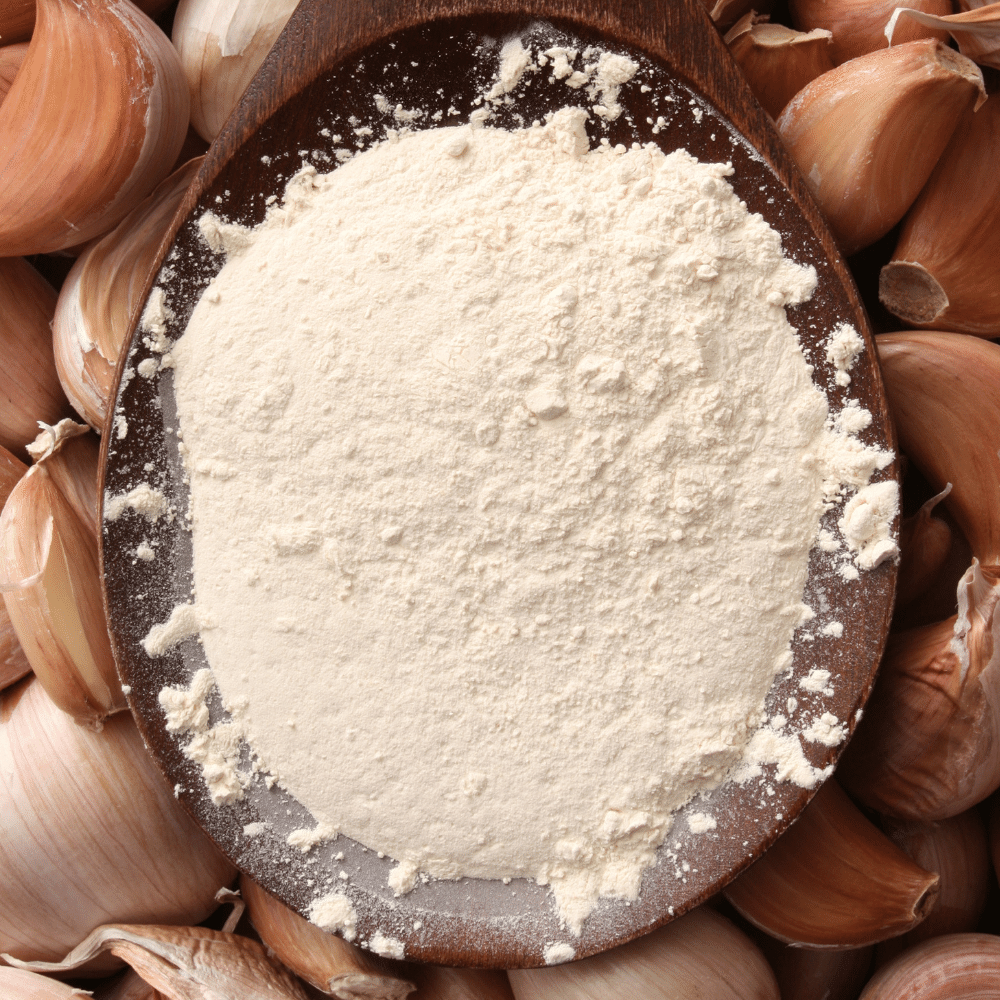
Garlic powder is an excellent addition to vegetable soup for two reasons: flavor and nutrition.
It adds a savory, unmistakable garlic flavor that complements just about any vegetable soup.
Garlic powder also contains essential nutrients.
As for how much you should use in your soup – start with 1 teaspoon per 4 servings of the soup.
Taste the finished product before adding more if desired; it’s easy to accidentally overpower the dish with too much garlic powder!
A heavier hand might be needed if cooking large amounts of soup or using kale (kale tends to have a bitter taste that can benefit from some extra garlic).
12. Onion Powder

We all know the power of onion in recipes, and it’s even more pronounced when its potent flavor is concentrated into powder form.
Onion powder really comes through in dishes with subtle flavors that tend to be overpowered by fresher onions.
It’s an easy way to add a nice punch without overpowering other flavors, so it works great for soups like vegetable soup.
Onion powder can also work well as a seasoning in sauces or stews if you don’t have fresh onions handy.
In terms of how much onion powder you should use for your vegetable soup, start small — about 1/4 teaspoon per cup of vegetables should do the trick.
Taste-test as you go, adjusting according to your preference until it’s just right!
13. Cardamom

Cardamom is one of those spices that can really boost the flavor of a dish.
But you don’t want to overdo it, otherwise, it can be too overpowering.
That’s why adding just the right amount of cardamom to your soup is key.
This spice adds warmth, sweetness, and a unique aroma that will take your veggie soup from average to out-of-this-world delicious!
But what makes cardamom such a great addition to vegetable soup?
Well, it contains compounds like cineole, which provide an intensely aromatic yet subtle taste when added in small doses.
In other words: It has just the right kick for your soup without masking any of its more delicate flavors.
14. Ginger

Ginger works very well in various types of dishes, including soups.
Its sweetness and pungency are just enough to liven up hearty broths and make them more interesting.
It also complements other flavors used in your soup like garlic, onion, peppers, etc., nicely.
When used in soups and stews, ginger is best added near the end of cooking so that it can still retain its aroma while not becoming too potent or overpowering the other ingredients you have added.
As for how much to use, a teaspoon of ground ginger should be good enough for 4 servings worth of soup – adjust according to preference though!
15. Fenugreek

Fenugreek is an aromatic herb with notes of cinnamon, nutmeg, and celery that pairs perfectly with vegetables like potatoes and green beans.
It’s also full of soothing properties that make it ideal for making soups.
When using fenugreek in your vegetable soup, you don’t have to measure exactly–just throw in about a teaspoon for a potful of soup – or as much as needed to get your desired result.
Because fenugreek has such potent flavors, remember that less is more – add too little and you won’t taste the flavor at all; add too much and the result will be quite bitter.
16. Turmeric

Thanks to turmeric’s earthy flavor, it can transform a run-of-the-mill veggie soup into something spectacularly delicious.
Plus, you get all those amazing nutrient benefits from that same spoonful of spice!
When cooking with turmeric, there’s really no wrong way to go about using it.
Start by adding ½ teaspoon per quart of vegetable broth and adjusting amounts according to your taste preferences — add more for additional intensity or mellow out by reducing the amount until the desired flavor is achieved.
To bring out a deeper flavor boost after cooking, try garnishing each bowl with an additional pinch or two right before serving.
17. Cumin

Cumin is an incredibly delicious and underrated spice that should be used more often, especially in vegetable soup.
This spice adds the perfect amount of smokiness and flavor to any dish without overpowering it.
But why is cumin awesome?
It’s easy!
Cumin has a unique flavor that pairs well with many ingredients like onions, peppers, potatoes, and tomatoes – you name it.
It also packs a hint of sweetness that helps to balance out other savory flavors, giving your soup an umami punch.
When using cumin for your veggie soup, start by measuring one teaspoonful for every two cups of broth (salt excluded).
You can then adjust depending on how much flavor you want in your finished product.
Start small to see how it goes – the intense flavor will add so much character to the already delectable combination of vegetables in your soup!
18. Coriander
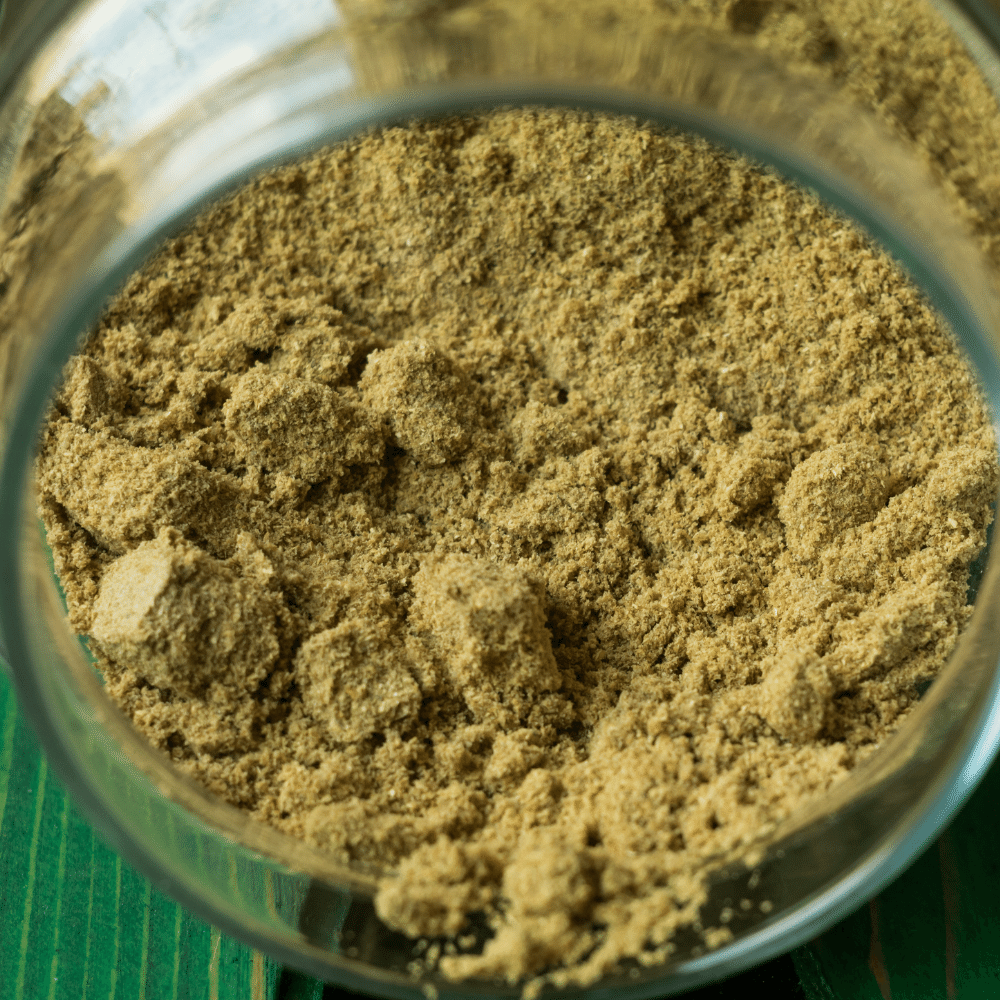
If you’ve ever had vegetable soup and noticed an earthy, yet refreshing flavor that stands out, that flavor was likely coming from the coriander.
Coriander has a unique aroma and taste that many people find pleasing.
Coriander is often used to add depth of flavor to soups, stews, and other dishes.
It pairs especially well with vegetables such as carrots, potatoes, celery, tomatoes, bell peppers, mushrooms, or onions in a vegetable soup.
The herb also helps to bring out the sweetness in some veggies like squash or sweet potatoes.
If you are adding coriander to your soup for the first time it is best to start with less at first (1 tablespoon for 4-6 servings).
Taste your soup later during cooking before adding more if desired.
Too much coriander can easily overpower other flavors so use caution with how much you add!
19. Cayenne Pepper

Cayenne pepper is an excellent addition to vegetable soup.
It adds a warm, spicy flavor that really takes the dish up another notch.
The best part?
You don’t have to use a lot of cayenne pepper in order to get flavor – just a pinch is usually enough!
This makes it perfect for those who are watching their salt intake.
When adding cayenne pepper, start small and season progressively as you taste until you hit the right balance between umami and heat – typically around ¼ teaspoon per quart of soup should be enough depending on how spicy you like your food.
The more veggies in the soup, the less spiciness you’ll need since they will naturally bring out some of their own flavors.
20. Bay Leaf

If you’ve ever made a traditional vegetable soup, then you know that bay leaf is an often-used ingredient. But why?
The answer to this question can be explained in two parts.
First off, bay leaf has an herbaceous scent with subtle woody and floral nuances.
This gives it the ability to highlight all of the other flavors present in your soup without overpowering them.
By adding just one or two leaves, you’ll get a balanced flavor profile where each ingredient works together harmoniously.
Plus, unlike many spices and herbs, bay leaves don’t become more pungent as they cook–so the flavor actually mellows over time rather than intensifying!
As for how much you should use: It depends on how strong of a taste you want for your soup–generally, about 2 or 3 medium-sized bay leaves will bring out enough aroma without overpowering the rest of the ingredients in your dish.
FAQ
What can I add to bland vegetable soup?
If you have some bland vegetable soup that needs some zing, then it’s time to add a few good ol’ fashioned ingredients.
A squirt of lemon or lime juice adds freshness and tartness to the mix.
If you’re looking for more flavor, try adding crushed garlic for an extra punch, along with fresh herbs like thyme, rosemary, or oregano.
For a bit of heat, include chili peppers or curry powder.
To make your veggie soup even heartier and richer tasting, add nuts such as almonds or cashews; dried fruits like raisins and cranberries; beans; cooked grains like quinoa; pieces of roasted squash; cooked potatoes and/or mushrooms – they make great accompaniments too!
Finally, top it off with parmesan cheese if desired- yum!
How do you make vegetable soup taste better?
Vegetable soup often requires a bit of jazzing up to really stand out.
Fortunately, these simple ingredients and methods can take your vegetable soup from ordinary to extraordinary.
- Begin by using fresh vegetables – if possible, stick to locally sourced seasonal produce for an even better flavor; for starters, onions and garlic are always great additions to any soup dish.
- For extra depth of flavor, try adding herbs like parsley or cilantro and spices such as oregano or thyme; you could even add vegetables that already have a deep taste like mushrooms or sun-dried tomatoes.
- To make the soup thicker in texture while adding more flavor, stir some tomato paste into it before simmering the ingredients together in a large saucepan with water or broth.
- Lastly, top off with cheese such as Parmesan which will give the most unexpected yet incredibly tasty kick.
What can you add to vegetable broth to make it taste better?
Vegetable broth has a mild, subtle flavor that can be hard to get excited about.
Luckily, there’s an easy way to take your broth from blah to yum!
The key is adding some simple spices and herbs.
Some classic additions include bay leaves, thyme, oregano, parsley, and garlic powder.
Salt and pepper also make a great addition.
If you’re feeling adventurous, add a pinch of turmeric or cumin for a bit more depth of flavor.
Not only will the extra spice jazz up your vegetable broth base – it’ll also boost the nutritional value with some anti-inflammatory benefits.
We all know that fresh veggies turn things up a notch – diced carrots and celery are especially delicious when added to veggie broths or stocks.
Onions bring loads of fantastic sweetness as well (which makes them one of my favorite additions).
And don’t forget mushrooms!
Their earthy flavor adds another dimension of savoriness while sneaking in some extra nutrients.
Keep in mind that you don’t have to limit yourself to just vegetables when making your own broth.
Nuts and seeds, like almonds and sesame seeds, bring a wonderful nutty flavor while adding some protein.
Dried mushrooms, like porcinis, impart an intense umami flavor, while seaweed adds a briny, ocean-like taste.
Related:
18 Best Herbs And Spices for Butternut Squash Soup
20 Best Herbs and Spices for Chicken Noodle Soup
27 Must-Have Herbs And Spices For Lentil Soup
17 Best Herbs and Spices for Chicken Soup
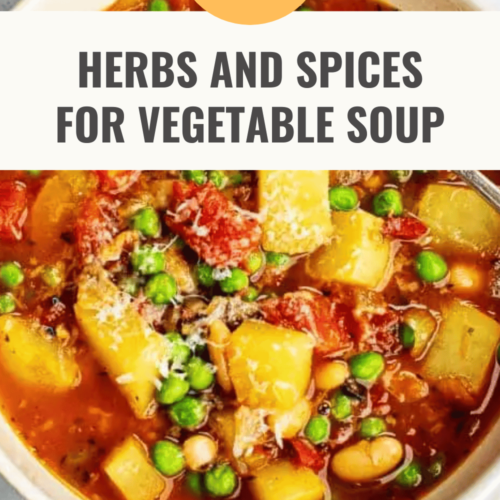
20 Must-Try Herbs and Spices for Vegetable Soup
Ingredients
- Parsley
- Thyme
- Dried Oregano
- Rosemary
- Salt
- Black Pepper
- Red chili flakes
- Italian seasoning
- Marjoram
- Basil
- Garlic Powder
- Onion Powder
- Cardamom
- Ginger
- Fenugreek
- Turmeric
- Cumin
- Coriander
- Cayenne Pepper
- Bay Leaf
Instructions
- Choose your favorite herbs or spices from this collection to add to your soup recipe.
- Prepare the rest of your delicious dish.
- Enjoy in no time!
Hi, I'm Benjamin. I love cooking, long walks, and my girlfriend! Here you’ll find simple and delicious recipes that you can make in 30 minutes or less.

